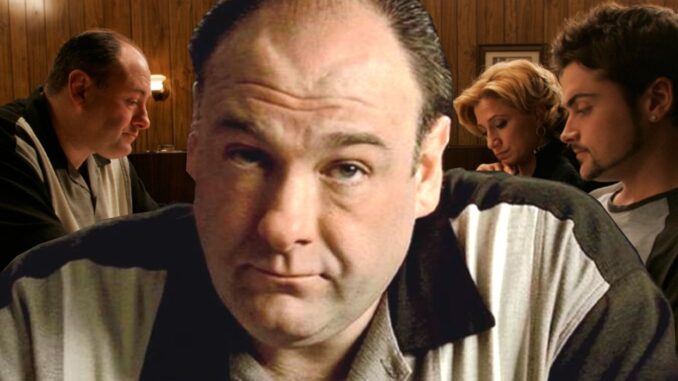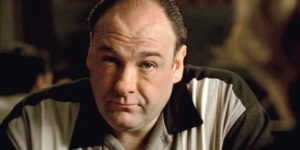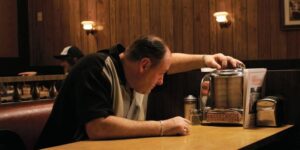
The Sopranos’ abrupt ending remains one of the most controversial series finales in TV history, but why did it happen and what does it actually mean? The Sopranos is considered one of the greatest television series ever made, and the zenith of the Golden Age (alongside The Wire), which makes the infamy around its ending all the more fascinating.
Created by David Chase, The Sopranos debuted in 1999 and is often credited as one of the series to help both establish HBO’s reputation as a serious player in the prestige drama market and usher in a new Golden Age of Television. The Sopranos centered around the life of Tony Soprano (James Gandolfini), an Italian-American mobster from New Jersey who attempts to balance his family life with being the mafia’s leader.
The show was lavished with praise across all six seasons of its run, winning plaudits for its cast and writing in particular, but the series finale proved extremely divisive when it aired in 2007, and that hasn’t changed 12 years on.
How The Sopranos Finale Ends

The series finale of The Sopranos, “Made In America”, picks up with Tony Soprano in hiding. What follows is one last go-around for the gangster: he strikes some deals, his rival Phil Leotardo is killed, and then goes to meet the rest of his family in a diner. It’s good, and it works as part of the build-up to the ending, but it’s also in keeping with much of what you’d expect from The Sopranos.
That changes when Tony gets to Holsten’s for a family get together. Arriving first, he puts Journey’s “Don’t Stop Believin'” on the jukebox, and waits for his family to arrive. Every time the door opens, Tony’s eyes dart upwards, as he watches various customers come into the parlor before the others eventually start to arrive: first Carmela, then A.J., and finally we see Meadow parking up outside. A bowl of onion rings is delivered to the table, we see a stranger go into the bathroom, and despite the music we get a great sense of tension building. Meadow gets out of her car, runs over to the door, the bell rings, Tony looks up, and… the screen cuts to black.
It was a moment that, in 2007, had millions of viewers across America genuinely convinced that their HBO had cut out or their TV sets were broken. Chase left audiences in total blackness for 10 seconds of confusion, surprise, and even anger, before the end credits started rolling. And just like that, The Sopranos was over. Not with a bang nor a whimper, but simply… vast nothingness.
What David Chase Has Said About The Ending

Given the ambiguous nature of The Sopranos’ ending, it’s no surprise that David Chase has been asked about it countless times over the years. The only trouble is that he’s the person who decided it shouldn’t be a clear-cut ending in the first place, and has little desire to explai too much. In an interview with Alan Sepinwall after the finale aired, Chase said: “I have no interest in explaining, defending, reinterpreting, or adding to what is there… No one was trying to be audacious, honest to God. We did what we thought we had to do. No one was trying to blow people’s minds, or thinking, ‘Wow, this’ll (tick) them off.’ People get the impression that you’re trying to (mess) with them and it’s not true. You’re trying to entertain them.”
They’re sentiments that, across the subsequent 12 years, Chase has largely tended to echo when questioned about the ending. Speaking to USA Today in 2012, he said: “People still ask me what happened. They don’t ask me if Tony is alive or dead. But I know that’s where it’s going. My answer is, if I was going to tell you that I would have told you. If he didn’t die that night he’s going to die very soon. And the problem is the same: there are the number of minutes in life and they go like this [makes a ticking sound]. They’re gone. And you don’t know when it’s coming. That’s all I wanted to say.”
These provide the essence of Chase’s comments – and those of everyone else involved in the show – since The Sopranos’ finale aired: that he knows what it means, it’s not meant to annoy fans or give them the finger, but he definitely isn’t interested in explaining it, except for one interview with Vox in 2014. There he reportedly said “no he isn’t” when asked if Tony was dead, but later released a statement saying his comments had been misconstrued. The closest he’s come recently to giving an answer was in an interview for the book The Sopranos Sessions, written by Sepinwall and fellow critic Matt Zoller Seitz, where he referred to it as “the death scene”, but later, when being informed of what he’d just said, clarified that he meant an earlier version of events – a few years before the finale, he had indeed planned an ending that featured Tony definitively dying, but later scrapped it for the more ambiguous conclusion.
The Real Meaning Of The Sopranos’ Sudden Ending
So, David Chase has said a lot about The Sopranos’ ending, but also hasn’t said much at all – which is exactly how it should be. It rarely works out well when artists and creators have to explain their work, and The Sopranos’ ending is much better when left open to interpretation. It’s given fans over a decade of engaging, passionate, and fascinating debate over what really happened, which is more than it would’ve got had Tony simply been killed, gone to jail, or, as Journey sang, seen his life “go on, and on, and on, and on.”
That, ultimately, is part of the point. Is Tony dead? Yes… but not necessarily in that moment. It’s entirely possible that the guy in the Members Only jacket walks out of the bathroom with a gun and shoots him. There’s certainly enough to support that: the similarities to The Godfather; the way it lingers on Meadow struggling to park, when she would’ve otherwise been sat next to Tony, and thus blocking Members Only Guy’s shot; the ringing – or tolling – of the bell; the blackness signalling death, like much of the imagery across the final season.
However, there’s also plenty to suggest Tony doesn’t die: the choice of song, “Don’t Stop Believin'”, and its aforementioned lyrics, are telling us that Tony’s life exists beyond this moment, we just aren’t going to be privy to it. It’s also, for a series that never did the obvious thing and defied codes and conventions of the genre, the most typical gangster ending possible for Tony to get whacked as the finale. Is that really what Chase would do with the last episode of The Sopranos?
The messaging here isn’t just that Tony’s life was in danger, and if he wasn’t killed in that moment, he would be eventually. That’s a big part of it, sure, but it’s also something that’s been apparent through almost the entire show. It’s reinforcing that message, not introducing it. But The Sopranos is a series that’s preoccupied by ideas of morality and philosophy, and that’s what Chase really wants us to be considering here. That all life is fleeting, and a series of choices that we need to reflect upon and learn from. Tony didn’t always make the right choices, nor take the right lessons. Did we as viewers? By fading to black, Chase invites us to consider not whether or not Tony died, but bigger questions and ideas about life and death. If the intent was simply to kill him off, then why make it ambiguous at all?
The Sopranos finale isn’t interested in giving us just one answer; in providing none, it leaves all of them on the table, and the choice we make is left to reflect on ourselves as much as it is the show. Perhaps the best way to look at it is that we the viewers get whacked, not Tony. We’re given, in that final scene of The Sopranos, the chance to experience some of the fear and paranoia that comes with being Tony Soprano. We’ve been told what death is like. Now we get to experience it ourselves. “You probably don’t even hear it when it happens, right?”
